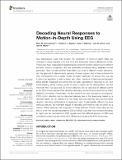Files in this item
Decoding neural responses to motion-in-depth using EEG
Item metadata
| dc.contributor.author | Himmelberg, Marc M. | |
| dc.contributor.author | Segala, Federico G. | |
| dc.contributor.author | Maloney, Ryan T. | |
| dc.contributor.author | Harris, Julie M. | |
| dc.contributor.author | Wade, Alex R. | |
| dc.date.accessioned | 2020-12-15T17:30:14Z | |
| dc.date.available | 2020-12-15T17:30:14Z | |
| dc.date.issued | 2020-12-10 | |
| dc.identifier | 271692988 | |
| dc.identifier | 581db323-d454-488b-836a-fff038fee95e | |
| dc.identifier | 85098169413 | |
| dc.identifier | 000601277600001 | |
| dc.identifier.citation | Himmelberg , M M , Segala , F G , Maloney , R T , Harris , J M & Wade , A R 2020 , ' Decoding neural responses to motion-in-depth using EEG ' , Frontiers in Neuroscience , vol. 14 , 581706 . https://doi.org/10.3389/fnins.2020.581706 | en |
| dc.identifier.issn | 1662-453X | |
| dc.identifier.other | Bibtex: 10.3389/fnins.2020.581706 | |
| dc.identifier.other | ORCID: /0000-0002-3497-4503/work/85562320 | |
| dc.identifier.uri | https://hdl.handle.net/10023/21152 | |
| dc.description | MH was supported by the European Union’s Horizon 2020 Research and Innovation Program under the Marie Skłodowska-Curie grant agreement no. 641805. AW was supported by United Kingdom Biotechnology and Biological Science Research Council (BBSRC) grant number BB/M002543/1, and JH by BBSRC grant number BB/M001660/1. | en |
| dc.description.abstract | Two stereoscopic cues that underlie the perception of motion-in-depth (MID) are changes in retinal disparity over time (CD) and interocular velocity differences (IOVD). These cues have independent spatiotemporal sensitivity profiles, depend upon different low-level stimulus properties, and are potentially processed along separate cortical pathways. Here, we ask whether these MID cues code for different motion directions: do they give rise to discriminable patterns of neural signals, and is there evidence for their convergence onto a single “motion-in-depth” pathway? To answer this, we use a decoding algorithm to test whether, and when, patterns of electroencephalogram (EEG) signals measured from across the full scalp, generated in response to CD- and IOVD-isolating stimuli moving toward or away in depth can be distinguished. We find that both MID cue type and 3D-motion direction can be decoded at different points in the EEG timecourse and that direction decoding cannot be accounted for by static disparity information. Remarkably, we find evidence for late processing convergence: IOVD motion direction can be decoded relatively late in the timecourse based on a decoder trained on CD stimuli, and vice versa. We conclude that early CD and IOVD direction decoding performance is dependent upon fundamentally different low-level stimulus features, but that later stages of decoding performance may be driven by a central, shared pathway that is agnostic to these features. Overall, these data are the first to show that neural responses to CD and IOVD cues that move toward and away in depth can be decoded from EEG signals, and that different aspects of MID-cues contribute to decoding performance at different points along the EEG timecourse. | |
| dc.format.extent | 13 | |
| dc.format.extent | 1748265 | |
| dc.language.iso | eng | |
| dc.relation.ispartof | Frontiers in Neuroscience | en |
| dc.subject | Motion-in-depth | en |
| dc.subject | steromotion | en |
| dc.subject | EEG | en |
| dc.subject | IOVD | en |
| dc.subject | CD | en |
| dc.subject | Multivariate decoding | en |
| dc.subject | Motion perception | en |
| dc.subject | BF Psychology | en |
| dc.subject | NDAS | en |
| dc.subject.lcc | BF | en |
| dc.title | Decoding neural responses to motion-in-depth using EEG | en |
| dc.type | Journal article | en |
| dc.contributor.sponsor | BBSRC | en |
| dc.contributor.institution | University of St Andrews. School of Psychology and Neuroscience | en |
| dc.contributor.institution | University of St Andrews. Institute of Behavioural and Neural Sciences | en |
| dc.identifier.doi | https://doi.org/10.3389/fnins.2020.581706 | |
| dc.description.status | Peer reviewed | en |
| dc.identifier.url | https://www.frontiersin.org/articles/10.3389/fnins.2020.581706/full#supplementary-material | en |
| dc.identifier.url | https://doi.org/10.1101/661991 | en |
| dc.identifier.grantnumber | BB/M001660/1 | en |
This item appears in the following Collection(s)
Items in the St Andrews Research Repository are protected by copyright, with all rights reserved, unless otherwise indicated.

